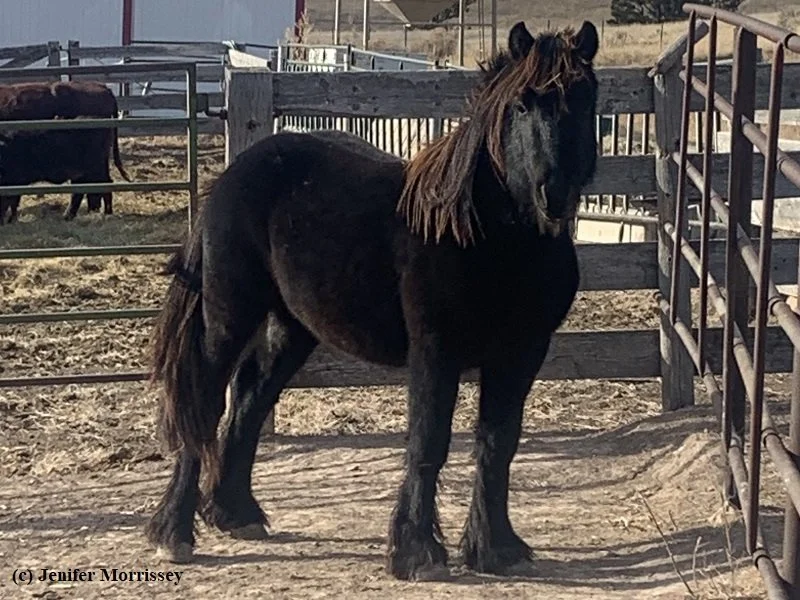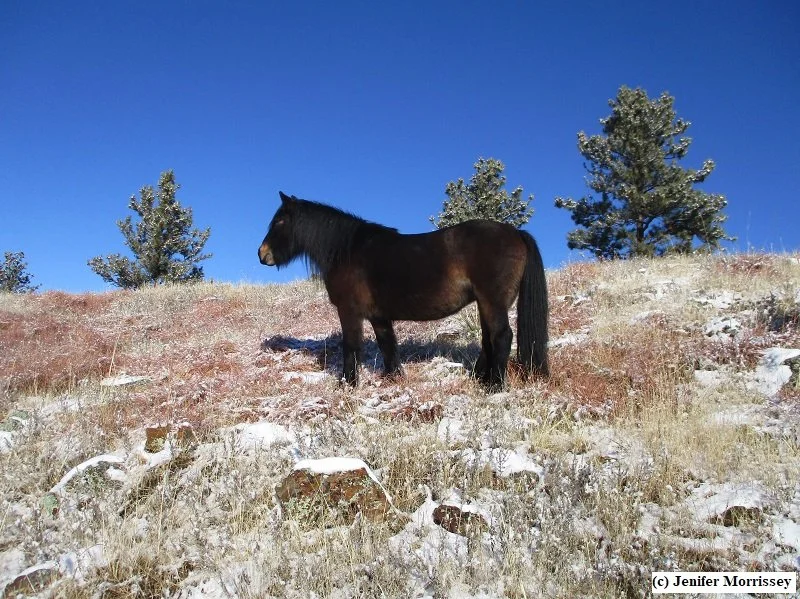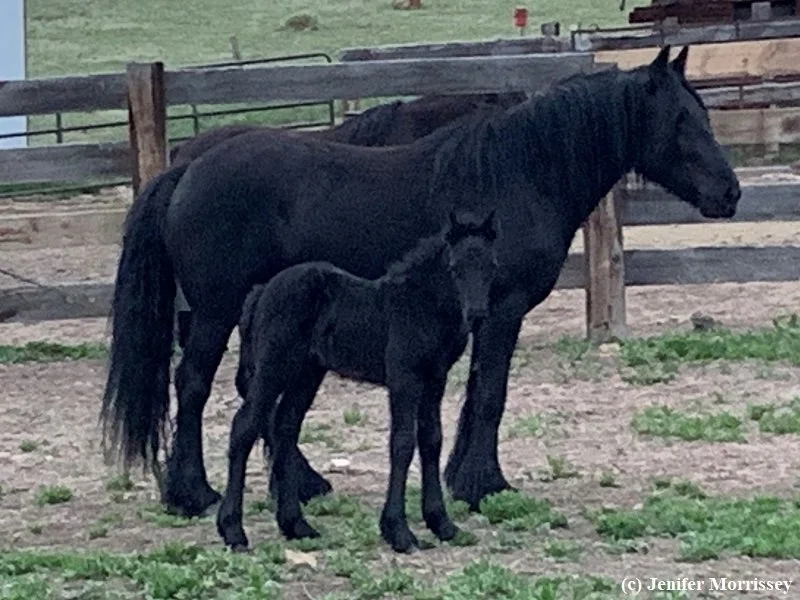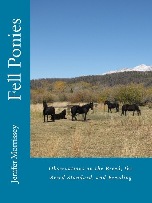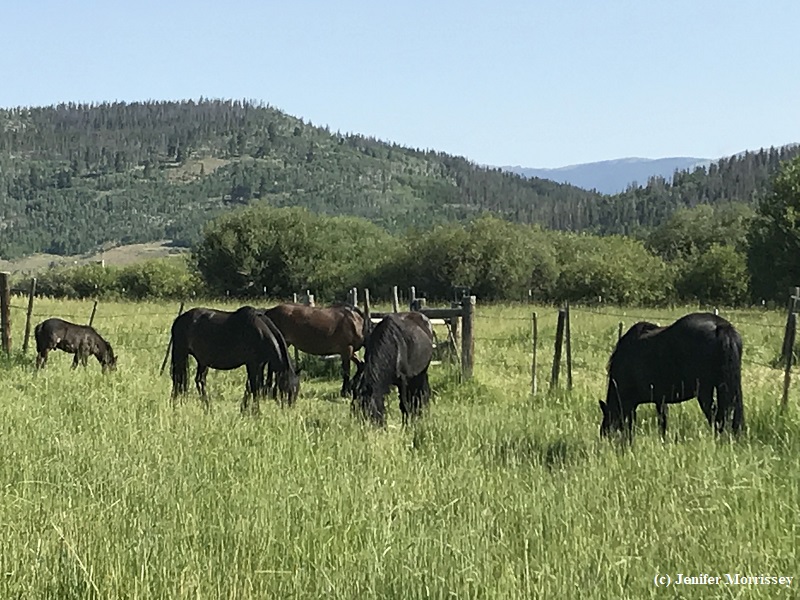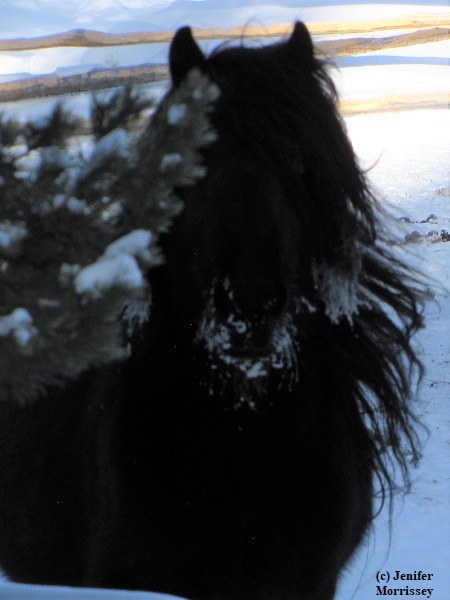The Bottleneck In Fell Pony History
/This article was originally published in August, 2024.
In 2006, after less than a decade of stewardship, I wrote my first version of “The Fell Pony As a Rare Breed.” One of the sections in that article was about the bottleneck in Fell Pony history. This article is an update to that discussion because, as with many other aspects of the Fell Pony’s status as a rare breed, I have learned a lot of context in the intervening years about that bottleneck.
Defining the Bottleneck
What I learned back in 2006 was that today’s registered Fell Pony population is based on fewer than 70 registered animals in the 1930s, a very small foundation population indeed. Note that there were more ponies registered during that decade, but only sixty-three of them contributed to today’s population.
The chart above shows the size of the registered breeding population for the 1930s, 1940s, and 1950s that has contributed to the current population, according to the pedigrees in the stud books of the Fell Pony Society. It is these small numbers of ancestors contributing to our much more sizable breeding population today (between 400 and 600 ponies since 2000) that lead some to ask why more people aren’t worried about the bottleneck. It’s a reasonable question. And the answer is that many people have been worried about the bottleneck for many years and have done things about it. And of course there’s always more we can do!
“Genetic” Bottleneck
First it’s important to understand what the bottleneck is and isn’t. Often, the bottleneck is called a genetic bottleneck. As students of Fell Ponies, however, we must be careful with this term. The chart above is based on pedigree data, not on genetic research based on DNA samples from actual ponies. In the Fell Pony, pedigrees and genetic research tell different stories. It is these different stories that have led me to view the bottleneck differently now than I did when I created the chart above.
The Story from Pedigrees
The story that Fell Pony pedigrees tell us is that we have a small gene pool, as the chart above suggests, because we had so few ancestors at one time. As we learned in the last installment of this series about the Fell Pony’s rare breed status, there is a 50/500 rule. Fewer than 50 breeding animals can lead to problems from inbreeding. Fewer than 500 breeding animals can lead to problems from genetic drift. (1) Even today the Fell Pony doesn’t have an effective population size of 500 animals. Foal Immunodeficiency Syndrome is sometimes given as an example of genetic drift which affects the future of the Fell Pony breed. The chart above suggests that the bottleneck from the perspective of pedigrees likely meant we were relying on fewer than 50 registered breeding animals in any given year during the 1930s. Therefore, one might conclude that our breed may have been ripe for problems from inbreeding.
The Story from DNA Research
On the other hand, the story that DNA research tells us is that our breed’s genetic diversity is relatively healthy. This is obviously a very different conclusion than what pedigree analysis tells us. In a 2019 paper by Clare Winton, et al., which looked at British and Irish pony breeds (2):
“...the [Welsh] Section D and Fell groups had the highest number of haplotypes (25 and 20, respectively) and also the highest haplotypic diversity values, while the Fell had the highest overall nucleotide diversity…” Haplotypes are groups of genes inherited from one parent. Nucleotides are basic building blocks of DNA. Thus, Winton, et. al, called out the Fell from all the other breeds for its high diversity values at the gene level.
“Fell ponies displayed very high maternal diversity, with a broad distribution of haplogroups, and moderately high nuclear diversity.” Winton, et al, especially called out the maternal diversity of the Fell Pony breed.
“The Fell and the Welsh populations have maintained the greatest maternal diversity of the ancestral British ponies…” It is striking to me that the Fell, a relatively rare breed, is compared to the Welsh, a relatively populous set of breeds, as having similarly high genetic diversity on the female side.
Why is it that our ponies’ pedigrees tell one story and DNA analysis based on their actual bodies tells another? The answer is that pedigrees in Fell Ponies are often inaccurate and are often incomplete. Hence, drawing conclusions based strictly on pedigrees must be done very carefully. The reasons for inaccurate and incomplete pedigrees stem in part from how past stewards of our breed tried to address the low numbers of registered ponies in the early twentieth century.
Globetrotter Moth is a product of the Grading Up scheme. His mother is a great granddaughter of an inspected mare.
The Bottleneck and the Inspection Scheme/Grading Up Program
The Fell Pony Society had several schemes in its first few decades to increase the numbers of registered ponies. One of the longest running schemes was inspection of ponies of ‘Fell type.’ Owners would identify ponies and then officials from the Fell Pony Society would inspect them and recommend them or not for registration. The Inspection Scheme was in place in various forms from 1912 to the 1970s.
The Grading Up program was implemented towards the end of the Inspection Scheme era, in the 1960s and 1970s. In the Fell Pony’s case, grading up meant putting registered stallions to inspected mares as well as those mares’ daughters and granddaughters. All male offspring had to be gelded. After three generations, the offspring were considered fully Fell. Prior to the Grading Up Scheme, stallions who had been inspected could contribute to the future of the breed immediately instead of three generations hence. Inspection and grading up schemes are common methods used by rare breed enthusiasts to conserve and expand breed numbers.
Bowthorne Matty has two unknown ancestors six generations back, circa 1948. Those branches in her pedigree are empty on paper but add diversity to her genetics.
A consequence of the Inspection Scheme was of course that the inspected ponies had incomplete pedigrees. Sometimes the sire was known and sometimes neither the sire or dam were known. In the 1930s, 40s and 50s, roughly 60 ponies were brought into the registered population to contribute to today’s Fell Pony population. (3) Because we don’t know the ancestors of those ponies, we don’t know if or how they were related to the other ponies in the breeding population. The ‘bottleneck’ says that we had just 63 registered ponies in the 1930s. Yet, the inspected ponies that were brought in of course had ancestors, even if they were unknown. Those ancestors would add to that small population of 63 ponies. We will never know how much they would add, but since our genetic diversity is higher than what our pedigrees suggest, they must have added diversity. And for that, we can be grateful to the Inspection Scheme and the many people who did that hard work (to read more about the Inspection Scheme, click here).
The Bottleneck and the Enclosure Scheme
The Enclosure Scheme was another scheme implemented by the Fell Pony Society to increase numbers of registered ponies. In place from 1945 to 1976, the Enclosure Scheme was unique to the Fell Pony breed. The Enclosure Scheme involved the Fell Pony Society securing land where a stallion could run with a herd of mares during the breeding season. The stallions were chosen at the Stallion & Colt Show each year, often by people planning to send mares to the enclosure for breeding.
Sometimes the Enclosure Scheme is said to have caused the bottleneck in the Fell Pony’s history. However, you’ll note in the chart above that a small breeding population pre-dates the Enclosure Scheme, so while it may have been a contributing factor, it wasn’t the only factor.
Three consequences of the Enclosure Scheme could have led to a narrowing of the number of Fell Pony ancestors in pedigrees. The first is that several stallions stood for more than one year in the enclosures, giving them the opportunity to sire many foals in a short period of time. It was also the case that large numbers of mares were served by the enclosure stallions in any given year, further allowing the genetics of those few stallions to be widely dispersed. Finally, several of the enclosure stallions were related, potentially further narrowing the number of ancestors in the breed. Yet the question remains: why is the Fell Pony’s genetic diversity healthy when the Enclosure Scheme seems to have concentrated genetics?
Globetrotter Hummingbird is a descendant of Linnel Romany II, one of the Enclosure stallions during the 1940s. Photo courtesy Libby Robinson
Pedigree Accuracy
One answer is certainly that our pedigrees are not accurate. While it was several years into my Fell Pony stewardship that I learned about the Enclosure Scheme, it was on the first day that I met a Fell Pony that I was told that Fell Pony pedigrees aren’t accurate. Since then I have learned many things beyond those related to the Enclosure Scheme that support this assertion. For instance, I’ve been told that one of the stallions in every modern day Fell Pony’s pedigree was not actually bred the way that his pedigree states. I have been told by more than one person that pedigree substitution, though obviously unacceptable by most standards, has nonetheless been practiced in our breed’s history to bring ponies (especially stallions) of good type into the breed that otherwise would be unavailable for pure breeding. If these newly papered animals were actually of diverse bloodlines, then they would have contributed to the relatively healthy genetic diversity that we have in our breed today. We can be thankful that breeders took the risk to bring these ponies into our breeding population.
There are at least two ways that inaccurate pedigrees may have resulted from the Enclosure Scheme in particular that could have resulted in increased genetic diversity for our breed while at the same time lower diversity in our pedigrees. First, when two different stallions were run on the same enclosure, it might not have been clear which one settled a particular mare since it was long before parentage confirmation via DNA testing. This confusion about sires could have happened, for instance, when two Linnel stallions ran at different times on the Nettles enclosure in 1945. While Linnel Raven II is behind every modern day Fell Pony, Linnel Romany II is behind less than a quarter of modern ponies. If a pedigree for a particular pony says it was sired by Linnel Raven II but it was actually sired by Linnel Romany II, that could increase the genetic diversity of that particular pony but the pedigree diversity would remain low.
The second instance might have come from a practice described by Elsie Dargue in Sue Millard’s book Hoof Prints in Eden about the Enclosure Scheme: “There got to be too many people popping mares in – it didn’t matter what – and scooting off with them before anybody came!” (4) The Fell Pony Society required mares to have a permit to be on the enclosures so that breedings could be tracked, which explains why people might ‘scoot off’ before anybody found out about illicit breeding. I can think of two possible reasons a mare owner might sneak their mare onto the Enclosure. One is if they couldn’t get their registered mare bred another way. And two is if their mare was bred by an unregistered stallion but they wanted the foal to be registered. If they could say the mare ran with the stallion on the Enclosure, whether they snuck it on or not, they could get the foal registered since at the time registration paper work was accepted very much on the honor system. It’s the second case that could have resulted in increased genetic diversity for the breed via the unregistered stallion while having less diversity in pedigrees which showed the Enclosure stallion.
In the context of the bottleneck, then, the lack of pedigree accuracy means that while pieces of paper say that our ponies are highly related, the reality of that relatedness might be something totally different because their ancestors aren’t who the piece of paper says they are. The genetic data we have, of course, supports this conclusion.
Sleddale Rose Beauty has a pedigree that is only complete to five generations. Some of her ancestors during the 30s, 40s, and 50s are unknown.
Incomplete Pedigrees
As described earlier, the aim of the Inspection Scheme was to increase the number of registered ponies by bringing unregistered ponies into the breeding population after being inspected. In most cases, the ancestors of those unregistered ponies were unknown. The consequence of that lack of information means that our ponies’ pedigrees, if we go back far enough, are not complete. For instance, my first Fell Pony mare, Sleddale Rose Beauty, had three inspected ancestors five generations back. Therefore, her pedigree was complete only to five generations. Before that, some of her ancestors were unknown.
A research paper on effective population size calculated the average equine generation to be 9.6 years. (5) This number closely corresponds with what I learned about the average length of the Fell Pony generation when populating my database back in time. (6) Let’s take Beauty as an example of how incomplete pedigrees is related to the purported bottleneck. Beauty was born in 1987. Since her pedigree is complete only to five generations, then her pedigree is incomplete before about 1939 (= 1987 - 5 x 9.6). That date is at the end of the decade when the chart above indicates we had a bottleneck. Some of Beauty’s ancestors, therefore, were unknown during the supposed bottleneck. They obviously existed and contributed diversity to Beauty’s genetics but they didn’t contribute diversity to her pedigree.
In another example, the pedigree for my current stallion Globetrotter Moth is only complete to four generations. He was foaled in 2022, so his pedigree is complete on one branch to only 1984 (= 2022 – 4 x 9.6). In another branch it is complete only to 1961. Therefore, many of Moth’s ancestors were unknown during the 1930s and 1940s when we supposedly had a bottleneck. It turns out that more than 95% of pedigrees of modern day Fell Ponies were not complete during the 1930s and 1940s. (7) If most of our modern ponies did not have complete pedigrees during the supposed bottleneck, then we can’t say for certain who all their ancestors were during the 1930s and 1940s. If we can’t say who all their ancestors were, we can’t say with any authority how healthy their genetic diversity was based just on pedigrees. We are fortunate, then, that Winton, et al, gave us the extraordinarily surprising information that, especially in our mares, we have healthy genetic diversity.
Conclusion
It is very important to recognize that Fell Pony pedigrees are not useful in determining the health of the genetic diversity of our breed. Our pedigrees are inaccurate and they are incomplete, so no conclusions based on them can be drawn about genetic diversity. On the other hand, we are indeed fortunate that some research has been done that suggests the genetic health of our breed, at least in the females, is relatively healthy. However, that is not to say that our breed is out of the woods from a genetic perspective. As I laid out in the last article in this series about effective population size (click here if you’d like to read it), the size of our worldwide breeding population based on pedigrees is still below the threshold that scientists consider healthy.
Where, as Fell Pony breeders, should we be putting our energy to improve our breed’s future genetically? I had one new prospective breeder tell me a few days ago that they wished to avoid using FIS carriers. I explained to them that that is not the wisest choice for our breed. Winton, et al, said as much: “The Fell ponies face the challenge of reducing the proportion of FIS carriers in the population, but great care must be taken to ensure unique ancestral maternal haplotypes are not lost in the process.” We must not eliminate carriers from our breeding population without extremely careful thought.
Here are some things that we can do as a worldwide breeder community; there are likely even more to be found:
Identify rare lines in the worldwide Fell Pony population that are worthy of conservation and use them in a conservation breeding program that ensures their continued presence in our breed.
Ponder the meaning of having maternal diversity and where to put efforts regarding conserving the different genders.
In Holland and North America where populations seem to be diverging from the UK population, look at how diverse our female lines are relative to the worldwide population and make adjustments accordingly.
Support additional DNA research when possible to give us additional information about our breed’s genetic health.
Regarding #1, I have identified overall rare lines in our breed and posted my findings on the internet (click here to read more). It is interesting to note that the majority of the ponies are female, as Winton et al suggested. I suspect there is more to learn about maternal lines, so I have put #2 on my to-do list!
Some say the minimum population size relative to genetic drift is even larger than 500.
Winton, Clare, et al. “Genetic diversity within and between British and Irish breeds: The maternal and paternal history of native ponies,” Ecology and Evolution, November 2019.
Morrissey, Jenifer. “Inspection Schemes and Grading Up,” Fell Ponies: Observations on the Breed, the Breed Standard, and Breeding, 2013, p. 56.
Millard, Sue. Hoofprints in Eden, Hayloft Publishing, Kirkby Stephen, Cumbria, 2005, p. 115.
Leroy, G., Mary-Huard, T., Verrier, E. et al. Methods to estimate effective population size using pedigree data: Examples in dog, sheep, cattle and horse. Genetics Selection Evolution, 45, 1 (2013). https://doi.org/10.1186/1297-9686-45-1
Original research as a byproduct of the Pedigree Information Service of raresteeds.com. Foals were entered in the database from 2000 back in time. When I reached 1993, sires and dams for foals from 2001 to 2003 were already entered, indicating that the breeding population was captured by a ten-year window of foal registrations.
In my pedigree database, the 1992 foal crop only includes ponies that contributed to the modern day population. Of those ponies, 95% had pedigrees that were five generations deep or less, which meant 1942 or more recent.



